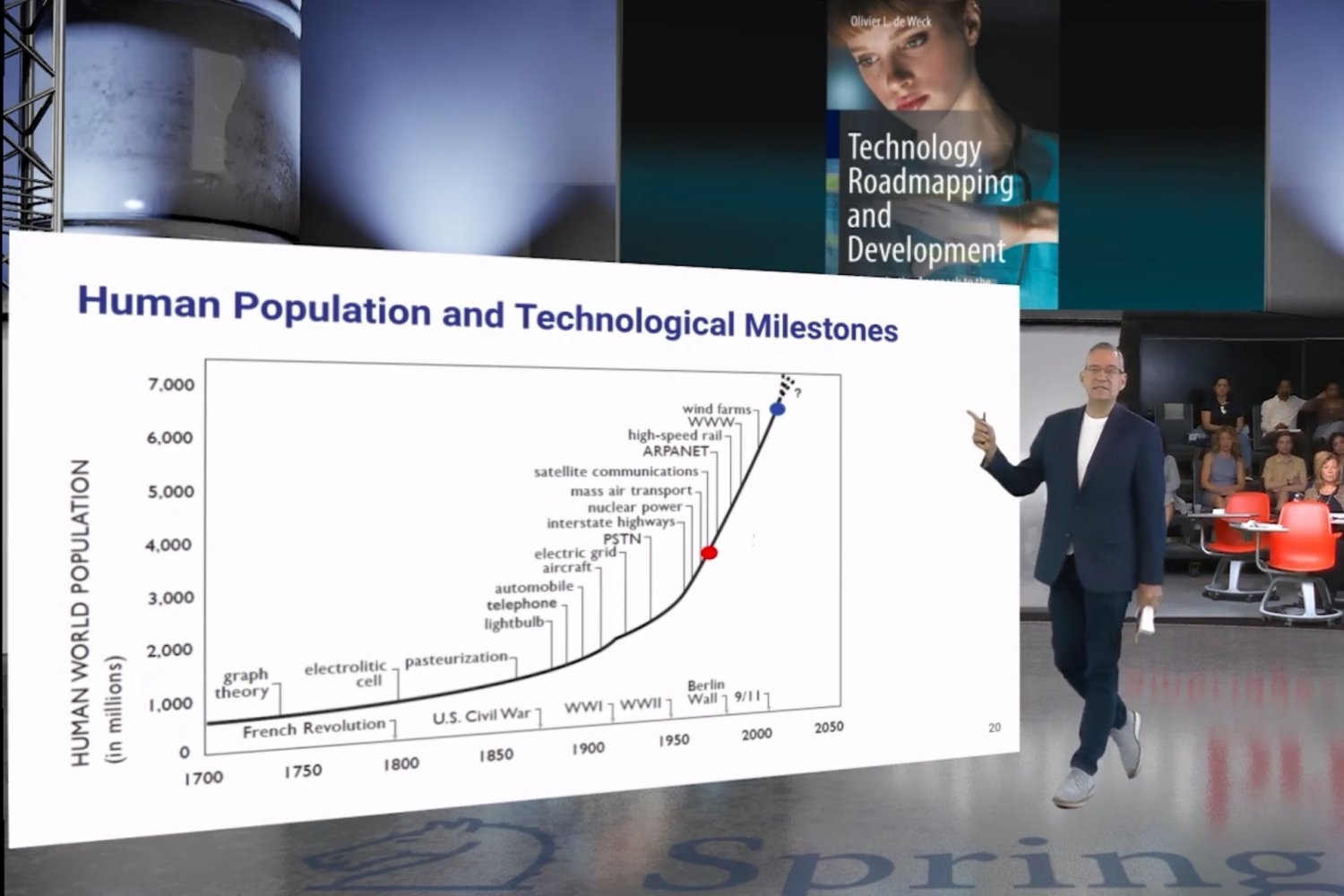
Innovation is rarely accidental. Behind every new invention and product, including the device you are using to read this story, is years of research, investment, and planning. Organizations that want to reach these milestones in the fastest and most efficient way possible use technology roadmaps.
Olivier de Weck, the Apollo Program Professor of Astronautics and professor of engineering systems, taps into his expertise in systems design and engineering to help company leaders develop their own path to progress. His work has led to an MIT graduate course, two MIT Professional Education classes, and the textbook “Technology Roadmapping and Development: A Quantitative Approach to the Management of Technology.” Recently, his textbook was honored with the Most Promising New Textbook Award from the Textbook and Academic Authors Association. The textbook not only serves as a guide to students but also to company leaders. Aerospace design and manufacturer Airbus, defense technology laboratory Draper, and package delivery giant UPS have implemented de Weck’s methods. Here, De Weck describes the value of technology roadmapping.
Q: What is technology roadmapping, and why is it important?
A: A technology roadmap is a planning tool. It connects current products, services, and missions to future endeavors, and identifies the specific technologies needed to achieve them.
Let’s say an organization wants to build a spacecraft to explore an asteroid in the farthest reaches of our solar system. It will need a new kind of electric thruster technology so that it can travel to the asteroid faster and more efficiently than what is currently possible. A technology roadmap details several factors, such as the level of performance needed to meet the goal and how to measure progress. The guide also links various responsibilities within an organization, including strategy, product development, research and development (R&D), and finance, so everyone understands the technologies that are being funded and how they will benefit the company.
Technology roadmapping has been in use for over five decades. For a long time, it was taught in business schools in a more general and qualitative way, but the practice has evolved over the years. The technology roadmapping I teach and write about uses quantitative engineering analysis and connects it to strategic thinking. From 2017 to 2018, I used and refined this approach for Airbus, which has a $1 billion R&D budget. Together, we developed over 40 technology roadmaps, which included a plan to build ZEROe, a commercial aircraft that will run on hydrogen fuel, by 2035.
Q: Are technology roadmaps used widely in industry today, and what gaps in knowledge/processes does your approach address?
A: Colleagues from the University of Cambridge and the Fraunhofer Institute in Germany and I recently conducted an industry-wide survey about technology roadmapping. Of the 200 companies that participated, 62 percent said they use technology roadmaps to make strategic investment decisions and 32 percent update them yearly. Yet only 11 percent of firms plan technologies 10 years out. This is a bit concerning because technology does not move as fast as many people believe. Using Airbus’s ZEROe aircraft as an example, it is important to think 10 or even 20 years ahead, not just within three to five years.
My approach to technology roadmapping uses a method I call Advanced Technology Roadmap Architecture (ATRA). It provides a step-by-step methodology to create a technology roadmap that is more rigorous and has a longer time horizon than traditional roadmaps. ATRA asks four essential questions: Where are we today, where could we go, where should we go, and where we are going? Instead of technologies, I want people to think of these questions as a guide to their retirement investing. You could invest in some high-risk mutual funds, low-risk bonds, or an index fund that will follow the market. You would pick investments that reflect your future goals and risk tolerances. ATRA works in the same way. It enables organizations to select the right mix of R&D based on different scenarios and different risk tolerances.
Q: Can you share how you designed your book and the courses, including 16.887/EM.427, to help students understand and apply technology roadmapping?
A: My time at Airbus allowed me to implement and battle-test technology roadmapping and ATRA. When I returned to MIT in 2019, I had already drafted chapters of the book and MIT students provided great feedback, which allowed me to refine and improve the book to the point where it would be useful and understandable to future MIT engineering and business students, industry practitioners, and C-level executives.
An important feature of both my textbook and class that may not be obvious is my focus on history. With innovation moving as fast as it is, it is easy to claim a never-been-done-before technology. That is often not the case — for example, one student did a technology roadmap of virtual reality headsets. He realized that people were doing virtual reality in the 1960s and 70s. It was super crude, clunky, and the resolution was poor. Still, there is a 60-year history that needs to be understood and acknowledged. My students and I have created a library of nearly 100 roadmaps on wide-ranging technologies, including superconducting nuclear fusion, lab-grown meat, and bioplastics. Each one traces an innovation’s history.
